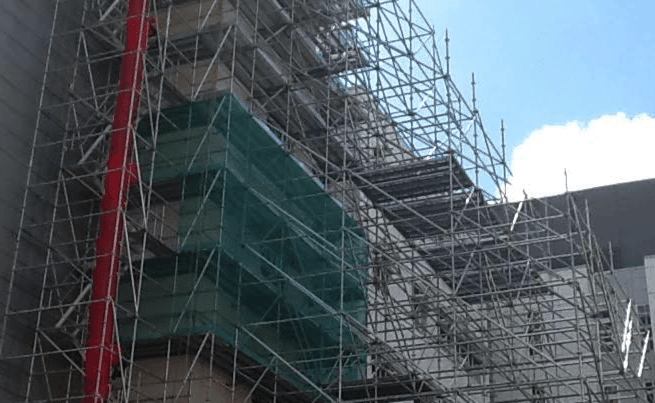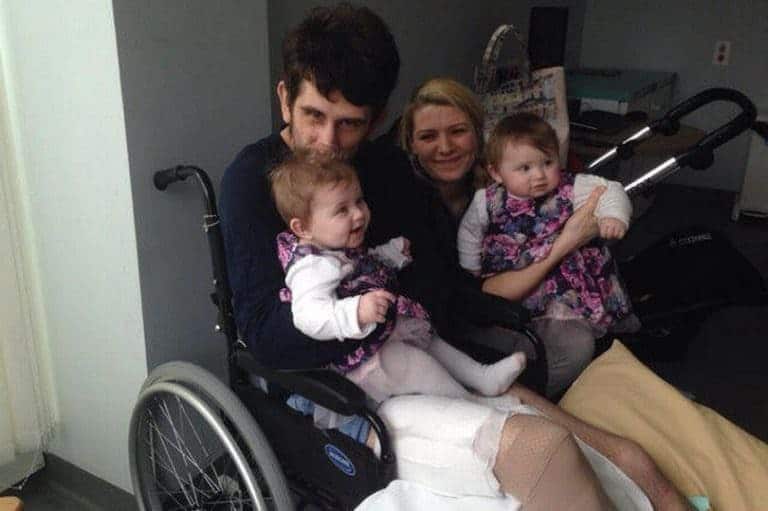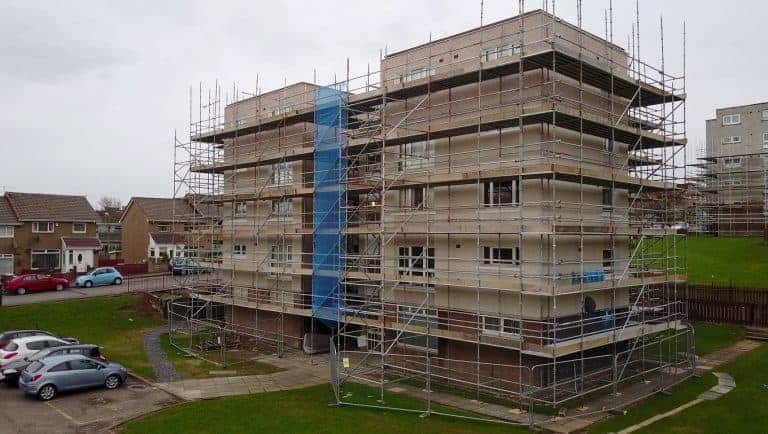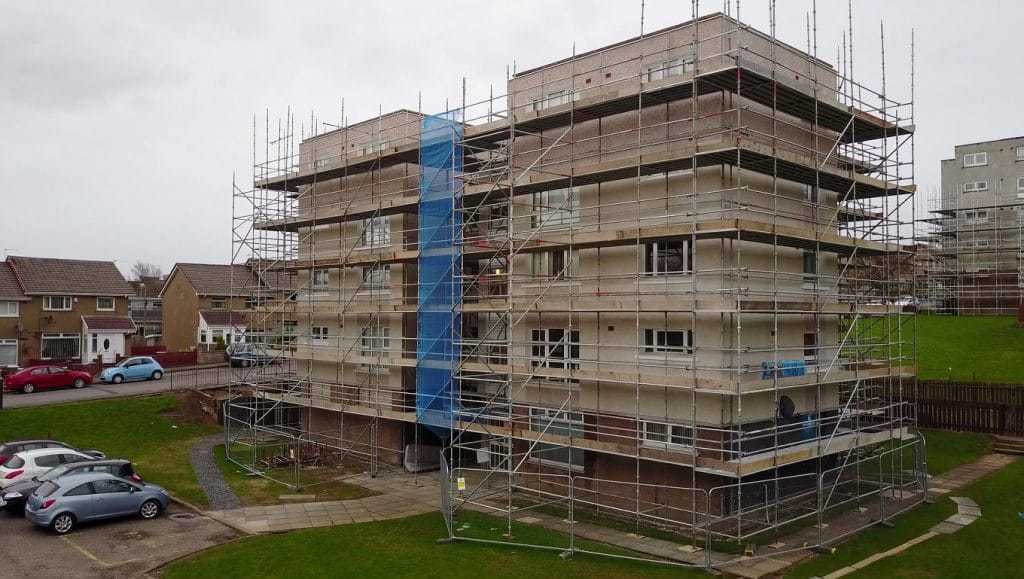 “The Confederation fully supports the introduction of the CISRS CPD requirement prior to card renewal”, said NASC President Alan Lilley of Commercial Scaffolding Ltd in Hull. “We see the benefits it will bring to the scheme, the individual card holder and their employers. We do realise however, as with all training these benefits do not come without costs. As such NASC is looking to reinvest a substantial amount of money into NASC member companies who support their employees through this process, and meet the costs of the CISRS CPD training.”
Operatives must hold a current valid CISRS Scaffolder or Advanced card renewed via the CISRS CPD 2-day course, to be eligible for funding. A link will be provided by NASC enabling members to complete an online application form in order submit a claim. Applications will be verified via the CISRS database prior to funding being released, with payments being made within four to six weeks for those who meet the criteria. Any individual member company will be limited to a maximum of 10 applications initially.
UK Scaffolding Contractors currently paying a CITB levy will be able to apply for a CITB short duration training daily attendance grant. This currently stands at £50 per day for employees completing CISRS CPD training. CITB are currently running a pilot scheme with NASC members which could see the daily attendance grant figure to be raised to £100 per day for those undertaking CPD when the new CITB funding is made available later this year. Again, this will be available to all both NASC and non NASC members
CISRS Scheme Manager Dave Mosley said: “It’s great to see the level of financial support NASC is willing to make available to assist their membership a possible figure of £50,000 and I hope I can convince them to consider further funding in 2018.”
A number of subsidised CPD courses will be available across the UK over the coming months. Though all will be open to employers, it’s strictly on a first-come-first-served basis. All will be limited to one candidate per company. CISRS with the support of National Construction College, LTC Group 87, Safety and Access Ltd and Simian Skill Ltd, will be running the scheme.
“The Confederation fully supports the introduction of the CISRS CPD requirement prior to card renewal”, said NASC President Alan Lilley of Commercial Scaffolding Ltd in Hull. “We see the benefits it will bring to the scheme, the individual card holder and their employers. We do realise however, as with all training these benefits do not come without costs. As such NASC is looking to reinvest a substantial amount of money into NASC member companies who support their employees through this process, and meet the costs of the CISRS CPD training.”
Operatives must hold a current valid CISRS Scaffolder or Advanced card renewed via the CISRS CPD 2-day course, to be eligible for funding. A link will be provided by NASC enabling members to complete an online application form in order submit a claim. Applications will be verified via the CISRS database prior to funding being released, with payments being made within four to six weeks for those who meet the criteria. Any individual member company will be limited to a maximum of 10 applications initially.
UK Scaffolding Contractors currently paying a CITB levy will be able to apply for a CITB short duration training daily attendance grant. This currently stands at £50 per day for employees completing CISRS CPD training. CITB are currently running a pilot scheme with NASC members which could see the daily attendance grant figure to be raised to £100 per day for those undertaking CPD when the new CITB funding is made available later this year. Again, this will be available to all both NASC and non NASC members
CISRS Scheme Manager Dave Mosley said: “It’s great to see the level of financial support NASC is willing to make available to assist their membership a possible figure of £50,000 and I hope I can convince them to consider further funding in 2018.”
A number of subsidised CPD courses will be available across the UK over the coming months. Though all will be open to employers, it’s strictly on a first-come-first-served basis. All will be limited to one candidate per company. CISRS with the support of National Construction College, LTC Group 87, Safety and Access Ltd and Simian Skill Ltd, will be running the scheme. NASC announce support for its members as CPD approaches
 “The Confederation fully supports the introduction of the CISRS CPD requirement prior to card renewal”, said NASC President Alan Lilley of Commercial Scaffolding Ltd in Hull. “We see the benefits it will bring to the scheme, the individual card holder and their employers. We do realise however, as with all training these benefits do not come without costs. As such NASC is looking to reinvest a substantial amount of money into NASC member companies who support their employees through this process, and meet the costs of the CISRS CPD training.”
Operatives must hold a current valid CISRS Scaffolder or Advanced card renewed via the CISRS CPD 2-day course, to be eligible for funding. A link will be provided by NASC enabling members to complete an online application form in order submit a claim. Applications will be verified via the CISRS database prior to funding being released, with payments being made within four to six weeks for those who meet the criteria. Any individual member company will be limited to a maximum of 10 applications initially.
UK Scaffolding Contractors currently paying a CITB levy will be able to apply for a CITB short duration training daily attendance grant. This currently stands at £50 per day for employees completing CISRS CPD training. CITB are currently running a pilot scheme with NASC members which could see the daily attendance grant figure to be raised to £100 per day for those undertaking CPD when the new CITB funding is made available later this year. Again, this will be available to all both NASC and non NASC members
CISRS Scheme Manager Dave Mosley said: “It’s great to see the level of financial support NASC is willing to make available to assist their membership a possible figure of £50,000 and I hope I can convince them to consider further funding in 2018.”
A number of subsidised CPD courses will be available across the UK over the coming months. Though all will be open to employers, it’s strictly on a first-come-first-served basis. All will be limited to one candidate per company. CISRS with the support of National Construction College, LTC Group 87, Safety and Access Ltd and Simian Skill Ltd, will be running the scheme.
“The Confederation fully supports the introduction of the CISRS CPD requirement prior to card renewal”, said NASC President Alan Lilley of Commercial Scaffolding Ltd in Hull. “We see the benefits it will bring to the scheme, the individual card holder and their employers. We do realise however, as with all training these benefits do not come without costs. As such NASC is looking to reinvest a substantial amount of money into NASC member companies who support their employees through this process, and meet the costs of the CISRS CPD training.”
Operatives must hold a current valid CISRS Scaffolder or Advanced card renewed via the CISRS CPD 2-day course, to be eligible for funding. A link will be provided by NASC enabling members to complete an online application form in order submit a claim. Applications will be verified via the CISRS database prior to funding being released, with payments being made within four to six weeks for those who meet the criteria. Any individual member company will be limited to a maximum of 10 applications initially.
UK Scaffolding Contractors currently paying a CITB levy will be able to apply for a CITB short duration training daily attendance grant. This currently stands at £50 per day for employees completing CISRS CPD training. CITB are currently running a pilot scheme with NASC members which could see the daily attendance grant figure to be raised to £100 per day for those undertaking CPD when the new CITB funding is made available later this year. Again, this will be available to all both NASC and non NASC members
CISRS Scheme Manager Dave Mosley said: “It’s great to see the level of financial support NASC is willing to make available to assist their membership a possible figure of £50,000 and I hope I can convince them to consider further funding in 2018.”
A number of subsidised CPD courses will be available across the UK over the coming months. Though all will be open to employers, it’s strictly on a first-come-first-served basis. All will be limited to one candidate per company. CISRS with the support of National Construction College, LTC Group 87, Safety and Access Ltd and Simian Skill Ltd, will be running the scheme. Spitfire Scaffolding Reaching For The Sky
BoS Family Business of the Year Winner constructing success
Spitfire Scaffolding is flying high as winners of the first BoS Family Business of the Year Award. Putnoe based Nigel, Barry and Stuart Corbett created the company in 2009 after they saw work drying up during the infamous credit crunch. All they had to their name was a single lorry, but just eight years later the business is quickly expanding as other family members join the firm. Orders have soared, enough for them to also look for a new apprentice. “Back when we started we were such a small business, we had just one loading bay for our equipment. “It was an amazing experience, the feeling when we won, it was a total shock and has been great ever since,” said Managing Director Nigel.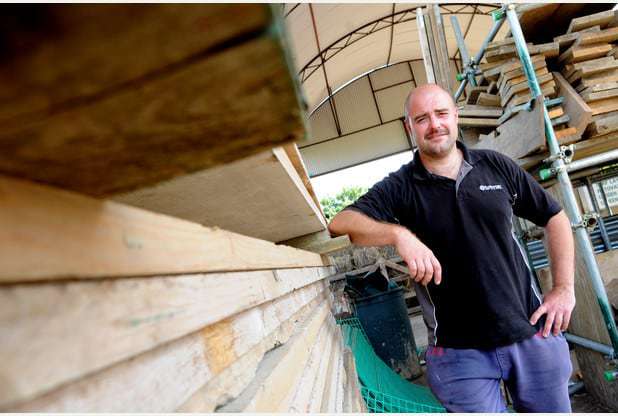
Godiva Erect Largest Free Standing Scaffolding in Coventry
Godiva Group have erected what is believed to be the tallest free-standing scaffolding in Coventry.
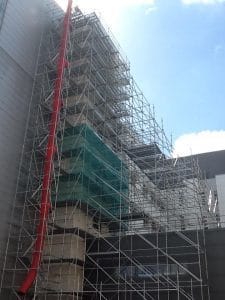 Godiva were contacted by Coventry’s University Hospital Maintenance contractor Vinci Facilities to assist with an emergency scaffold at the hospital, due to the potential of spalling Render on an area of the building adjacent to the emergency ambulance entrance.
Godiva contacted system manufacturer AtPac who produced a fully buttressed free-standing system design within 12 hours. No ties were permitted into the building fabric due to it being rendered, patching difficulties as well as a lack of through tie opportunities.
Godiva commenced the structure following design approval the next day and the structure was erected by a team of 4 operatives within 7 working days to a height of 28m with a fully buttressed supporting scaffold. The free-standing structure incorporated two public protection gantries a full height system staircase for operative access both during erection and for the client, as well as a fully decked façade access scaffolding. A full height rubbish chute was added as a designed item a few days later for material removal at high level.
Godiva were contacted by Coventry’s University Hospital Maintenance contractor Vinci Facilities to assist with an emergency scaffold at the hospital, due to the potential of spalling Render on an area of the building adjacent to the emergency ambulance entrance.
Godiva contacted system manufacturer AtPac who produced a fully buttressed free-standing system design within 12 hours. No ties were permitted into the building fabric due to it being rendered, patching difficulties as well as a lack of through tie opportunities.
Godiva commenced the structure following design approval the next day and the structure was erected by a team of 4 operatives within 7 working days to a height of 28m with a fully buttressed supporting scaffold. The free-standing structure incorporated two public protection gantries a full height system staircase for operative access both during erection and for the client, as well as a fully decked façade access scaffolding. A full height rubbish chute was added as a designed item a few days later for material removal at high level.
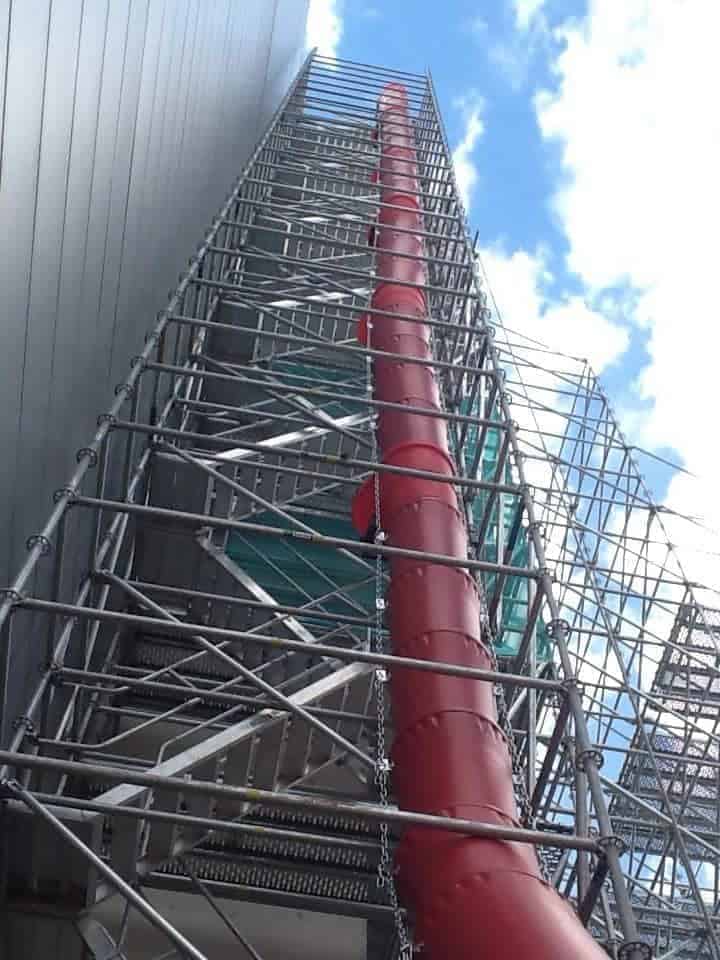 Managing Director Colin Taylor said “this was our first experience utilising the AtPac system and from the initial design through to project completion i have been impressed with both the response and overall level of service provided.”
“The system provided an increased level of safety, reduced manual handling , whilst increasing output levels, resulting in a delighted client and a quality finish, a great effort all round, a real platform for success for all concerned in my view.”
Managing Director Colin Taylor said “this was our first experience utilising the AtPac system and from the initial design through to project completion i have been impressed with both the response and overall level of service provided.”
“The system provided an increased level of safety, reduced manual handling , whilst increasing output levels, resulting in a delighted client and a quality finish, a great effort all round, a real platform for success for all concerned in my view.”
Wood Group wins industrial services contract for Royal Navy submarines
Wood Group has been awarded a new industrial services contract by BAE Systems Submarines.
Effective immediately, the two-year contract is to provide insulation installation services to the UK Royal Navy’s Astute class submarines based in Barrow-in-Furness, and includes up to three one-year extension options. Wood Group is currently contracted by BAE Systems to provide a range of industrial services including painting, cleaning and insulation to the Royal Navy’s existing surface ship fleet and its Queen Elizabeth class aircraft carriers under construction in Rosyth. Dave Stewart, CEO for Wood Group’s Asset Life Cycle Solutions business in the Eastern Hemisphere, said: “Wood Group has supported the Royal Navy for 40 years in the provision of marine painting. This award builds on our reputation for providing industrial services and protective insulation technologies to the marine sector. “We look forward to continuing our strong collaborative relationship with BAE Systems, delivering engineered hull and pipe insulation to the Astute class – the Royal Navy’s largest and most powerful fleet of attack submarines.”Electrocuted Scaffolder Returns Home
Jamie Mines on the mend following scaffolding nightmare
Scaffolder Jamie Mines who lost both arms and a leg following a massive electric shock on a five metre high scaffold has been allowed home from hospital. The 33-year-old dad of two and talented lower league footballer from Somerset, has spent six months recovering following his horrific injuries sustained while helping construct the scaffolding. Jamie was taken to Southmead Hospital just two weeks before Christmas after the accident at Kendrick Industrial Estate on Galton Way in Swindon. The injuries were so severe he was placed into an induced coma and also lost the toes on his remaining leg. His girlfriend Harley Ware kept a bedside vigil as he lay in a serious condition while friends set up a fundraising page to support his young family. She revealed: “After being told of his electric shock my heart sunk. It just kept getting worse. It seemed every time I’d get a phone call was to tell me that he’d have another limb removed. I couldn’t stop crying all week, each time something else had happened. But the overwhelming support for Jamie from strangers around the world kept him going.”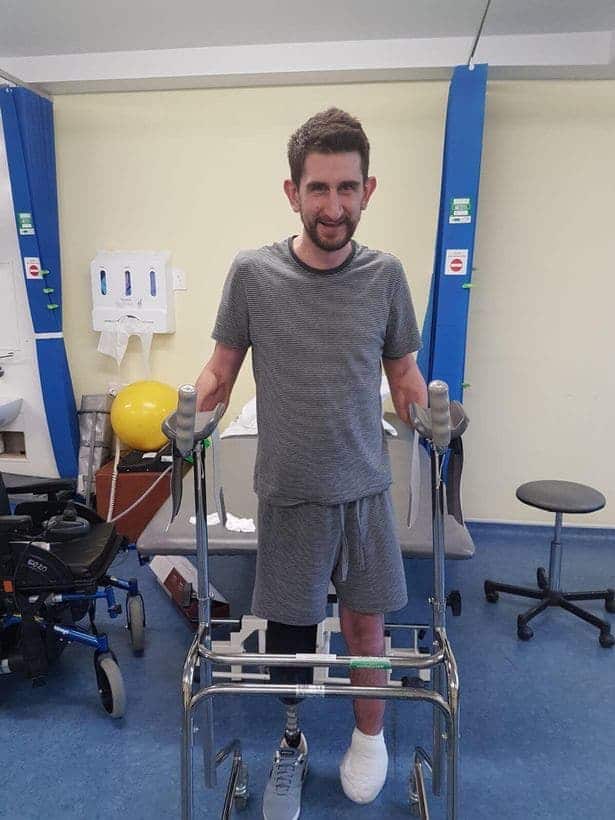
Three-year Scaffolding Project Gets Underway at Big Ben
 “This historic clock is loved by so many people. It is both an honour and a great responsibility to keep it in good working order for public enjoyment. Every day our team of highly skilled clock mechanics cares for this Victorian masterpiece but, in order to keep the Clock ticking, we must now take the time to thoroughly inspect and restore it.
These essential works balance value for money with Parliament’s custodial responsibility to the building as well as to those visiting and working in the Elizabeth Tower. This project will enable us to give one of Britain’s most famous landmarks the TLC it so desperately needs and deserves.”
“This historic clock is loved by so many people. It is both an honour and a great responsibility to keep it in good working order for public enjoyment. Every day our team of highly skilled clock mechanics cares for this Victorian masterpiece but, in order to keep the Clock ticking, we must now take the time to thoroughly inspect and restore it.
These essential works balance value for money with Parliament’s custodial responsibility to the building as well as to those visiting and working in the Elizabeth Tower. This project will enable us to give one of Britain’s most famous landmarks the TLC it so desperately needs and deserves.”
Avontus Software Launches Global Web Presence
 “Our customers want to buy our software and instantly use it. A good portion of our business is Pay-As-You-Go, which is a subscription that has an affordable startup fee and a small monthly payment. After purchasing, customers are able to activate and use their new software within minutes. They can also log on and manage their payment methods and activate or deactivate their software online whenever they want,” says Andrew Smith, Avontus UK Sales.
Both Avontus.com and Avontus.co.uk are mobile-friendly sites that run on secure https, ensuring that all customer visits are encrypted.
In addition to the helpful content found on the site, how-to videos are kept up to date with the current releases of the software. Additionally, visitors are not required to provide personal information or create an account to see how the software works.
Manufacturer catalogues are freely downloadable on both websites to support the ever-expanding manufacturer base that is supported in Scaffold Designer.
“Not only do we work to constantly improve software for our customers, we also recognize the need to automate our internal processes. This keeps us efficient internally and allows self-service for our customers,” says Brian Webb, Avontus Founder and CEO.
For more information please visit Avontus at https://www.avontus.com or https://www.avontus.co.uk/.
“Our customers want to buy our software and instantly use it. A good portion of our business is Pay-As-You-Go, which is a subscription that has an affordable startup fee and a small monthly payment. After purchasing, customers are able to activate and use their new software within minutes. They can also log on and manage their payment methods and activate or deactivate their software online whenever they want,” says Andrew Smith, Avontus UK Sales.
Both Avontus.com and Avontus.co.uk are mobile-friendly sites that run on secure https, ensuring that all customer visits are encrypted.
In addition to the helpful content found on the site, how-to videos are kept up to date with the current releases of the software. Additionally, visitors are not required to provide personal information or create an account to see how the software works.
Manufacturer catalogues are freely downloadable on both websites to support the ever-expanding manufacturer base that is supported in Scaffold Designer.
“Not only do we work to constantly improve software for our customers, we also recognize the need to automate our internal processes. This keeps us efficient internally and allows self-service for our customers,” says Brian Webb, Avontus Founder and CEO.
For more information please visit Avontus at https://www.avontus.com or https://www.avontus.co.uk/. Meet the scaffolder with his pet goat

Scaffolder fights for life after Manchester bomb attack
A Scaffolder is fighting for his life after being caught up in the terror attack on Monday night.
Phil Hassall, originally from Runcorn, was at the Manchester Arena when a suicide bomber detonated an explosion, killing 22 and injuring 120 as concert goers were leaving the Ariana Grande gig.
Actavo and Northseal constructing the perfect partnership
Actavo Hire and Sales Glasgow branch has constructed a partnership with Northseal to supply scaffolding for vital projects. Their latest joint activity is the supply of scaffolding for a £130,000 project on behalf of East Ayrshire Council.
The current contract with East Ayrshire Council involves Actavo supplying scaffolding solutions to install external wall insulation to homes on the New Farm Loch estate. This combination of medium-rise residential blocks and terraced homes, emerged between 1968 and the mid 1970’s. And now the properties are badly in need of new insulation, meaning large volumes of scaffolding are required.
Billie-Jane Calder, Actavo’s area sales representative, said: “The local authority was carrying out insulation work throughout the estate to improve the energy efficiency of the older housing stock. As the appointed scaffolding contractor, Northseal needed a supplier to provide large volumes of scaffolding to cater for both the blocks of flats, and the long runs of terraced homes which were all being worked on concurrently. From the installation perspective, we needed to supply a quick and easy solution so that work could start as soon as possible, thereby minimising disruption for residents.”
The project will see Actavo utilising the K-Lock system, a unique method of connecting ledgers and transoms to the standards in one, single action without using nuts, bolts or wedges. This node-locking principle makes K-Lock one of the fastest systems to install. Northseal of course, supplies and erects scaffolding to commercial, private and local authority customers throughout Scotland, from their Galston base in East Ayrshire.

Speaking about the partnership, director at Northseal Scaffolding, Lara Zavaroni, explained: “We’ve been working with Actavo’s Glasgow branch for just over nine months and our business relationship has always been very professional. Our business with each other is expanding month by month. Actavo is our main supplier. We look forward to having a continuing relationship with such a progressive company.”
Actavo has worked with Northseal to supply scaffolding services for residential blocks at Prestwick Toll, the Stewarton housing project and the Kelloholm project.

